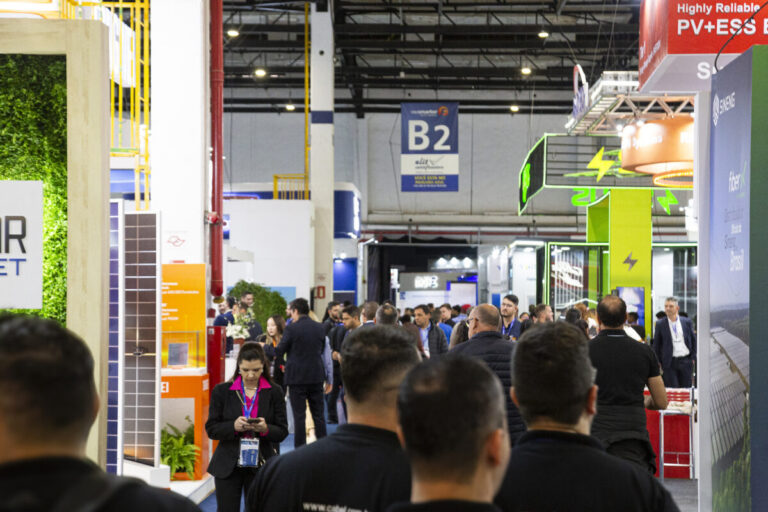The Intersolar South American trade fair attracted 650 exhibitors and 55,000 visitors in August, highlighting the industry’s growth with new pavilions on storage and electric mobility. According to Brazilian PV association ABsolar, Brazil is on track to reach 47.2 GW of installed solar capacity by the end of this year, with 11 GW of new PV capacity.
The Intersolar South America 2024, held in Sao Paulo at the end of August, demonstrated the resilience of the Brazilian PV market in the face of global challenges such as overcapacity, price pressure and consolidation. This year’s event expanded in size and scope, with two new pavilions dedicated to storage and electromobility.
“The event registered more than 650 exhibitors, approximately 55,000 visitors and approximately 2,500 conference visitors,” says Florian Wessendorf, director of the event organizer told pv magazine. “Last year we had about 550 exhibitors and for this year we aimed to exceed the 600 threshold.”
Wessendorf said this year’s event saw a higher level of international participation among exhibitors than last year, with 55% coming from abroad and 45% from Brazilian companies. This shift contrasts with last year’s trend, when the majority of participants were Brazilian. Wessendorf claimed that given ongoing industry consolidation, this trend could potentially reverse next year.
The scale and success of the event highlight the strong growth trajectory of the Brazilian PV market. Developers in the country have deployed about 10 GW in 2023 and are expected to add another 10 GW to 12 GW this year.
ABsolar originally called for 9 GW of new solar capacity by 2024, but has now increased its forecast to 11 GW. Despite the favorable long-term outlook, the sector faces short-term challenges.
Since the August 2023 power outage, Brazil has experienced more frequent outages in centralized generation, with some generators losing up to 80% of expected energy. These disruptions mainly occur on weekends, when consumption is lower.
ABsolar estimates that disruptions caused by the grid operator cost approximately BRL 300 million ($53.3 million). French company Voltalia expects a €40 million ($44.2 million) impact on its earnings before interest, taxes, depreciation and amortization (EBITDA) in 2024 due to cuts in renewable energy generation. The reimbursement of energy losses due to transmission system restrictions remains unresolved; only in a few cases are these expected to be reimbursed.
ABsolar managing director Ronaldo Koloszuk said electricity consumption will increase due to the electrification of energy and economic decarbonization once these issues are resolved. In distributed generation, energy suppliers have reported grid saturation issues, often reversing the flow of energy to deny new connection requests.
“Out of every 100 consumer units in the country, only four are supplied by solar energy. In Australia there are thirty. So there is still a lot of room to grow,” says Koloszuk.
Trade associations find the existing regulations inadequate and now support a legislative solution. Bill 624/2023, which amends law 14.300, would oblige distributors to present technical studies to justify any restrictions on electricity injection from micro-generation systems (up to 75 kW).
A coalition has been formed to advocate this proposal in Congress, including the National Confederation of Agribusiness and the Brazilian Micro and Small Business Support Service (SEBRAE).
Public policy
Despite challenges in connecting both centralized and distributed generation, solar energy in Brazil continues to grow in line with global trends. At the end of 2023, global solar energy capacity stood at 1,581 GW, with 407 GW added that year. The sector could reach 2 TW in 2024 with an additional 544 GW, and is expected to reach 5.1 TW in 2028.
This growth stems from the growing competitiveness of PV technology in various applications, including floating and agrovoltaic systems.
Brazil ranked sixth in accumulated solar power generation capacity at the beginning of 2024, adding 15.4 GW, making it the third country with the most new installations. However, Brazil still does not have a government policy with specific renewable energy targets.
Absolar president Rodrigo Sauaia suggested at the opening of Intersolar 2024 that Brazil could achieve 100% renewable electricity by 2030 and set broader goals to clean up its energy mix.
“We need to rebalance and accelerate. As long as the public sector supports fossil fuels, they will have more power,” Sauaia said. “Incentives for renewables, both for distributed generation and for large projects, will legally end. There is no end in sight to fossil fuel incentives.”
This content is copyrighted and may not be reused. If you would like to collaborate with us and reuse some of our content, please contact: editors@pv-magazine.com.


